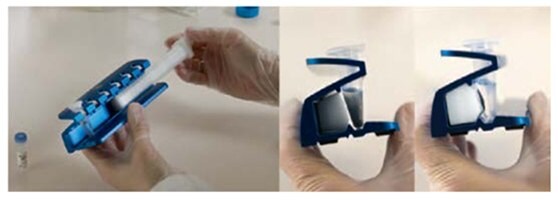Performing a Purification of IgG Antibodies with Protein A Mag Sepharose® Xtra or Protein G Mag Sepharose® Xtra
Protein A Mag Sepharose® Xtra and Protein G Mag Sepharose® Xtra products are magnetic beads designed for high capacity small-scale purification/screening of monoclonal and polyclonal antibodies from various species.
Protein A Mag Sepharose® Xtra and Protein G Mag Sepharose® Xtra provide flexible purification allowing a wide range of sample volumes and easy scaling up by varying the bead quantity.
The magnetic bead format has excellent properties for small-scale experiments. The high density of the beads allows rapid capture by magnetic devices while the visibility of the beads ensures reliable collection of the bound antibodies in the purification procedure. The products are provided with protocols optimized for antibody purification.
MagRack™ 6 enables preparation of up to six samples captured in 1.5 mL microcentrifuge tubes (Figure 3.27). When the tubes are placed in the rack, the magnetic beads are attracted to the magnet within a few seconds. This allows easy removal of the supernatant whereas the magnetic beads are left in the tube. MagRack™ Maxi is suitable for volumes up to 50 mL, for example, capture of antibodies in low titer from a larger volume.

Figure 3.27.The high density of Mag Sepharose® beads allows rapid capture by MagRack™ 6 magnetic device.
For immunoprecipitation, it is recommended to use the Protein A Mag Sepharose® and Protein G Mag Sepharose. These products have optimized capacities for immunoprecipitation applications, see Immunoprecipitation techniques for more information.
Advice on handling magnetic bead medium
Protein A Mag Sepharose® Xtra and Protein G Mag Sepharose® Xtra are intended for single use only.
1.5 mL Eppendorf tubes and MagRack™ 6 should be used in the protocol. When using volumes above 1.5 mL, for example larger volumes up to 50 mL, MagRack™ maxi is recommended.
General magnetic separation step
- Remove the magnet before adding liquid.
- Insert the magnet before removing liquid.
Dispensing the medium slurry
- Prior to dispensing the medium slurry, make sure it is homogeneous by vortexing.
- When the medium slurry is resuspended, immediately pipette the required amount of medium slurry into the desired tube.
- Repeat the resuspension step between each pipetting from the medium slurry vial.
Handling of liquid
- Use the magnetic rack with the magnet in place for each liquid removal step.
- Before application of liquid, remove the magnet from the magnetic rack.
- After addition of liquid, allow resuspension of the beads by vortexing or manual inversion of the tube. When processing multiple samples, manual inversion of the magnetic rack is recommended.
Incubation steps
- During incubation steps, make sure the magnetic beads are well resuspended and kept in solution by end-over-end mixing or by using a benchtop shaker.
- Incubation steps generally take place at room temperature. However, incubation can take place at +4 °C over night if this is the recommended storage condition for the specific sample.
- When purifying samples of low concentrations or large volumes, an increase of the incubation time might be necessary.
- If needed, a pipette can be used to remove liquid from the lid.
Sample preparation
Refer to Desalting and buffer exchange for general considerations.
Check the pH of the sample, and adjust if necessary before applying the sample to the beads. The pH of the sample should equal the pH of the binding buffer. Adjusting the pH could be done by either diluting the sample with binding buffer or by buffer exchange using PD MiniTrap™ G-25 or HiTrap™ Desalting.
Clarification of sample might be needed before applying it to the beads.
Buffer preparation
Binding buffer: PBS (137 mM sodium chloride, 2.7 mM potassium choride, 100 mM sodium hydrogen phosphate, 2 mM potassium hydrogen phosphate), pH 7.4
Elution buffer: 100 mM glycine-HCl, pH 2.8
Neutralizing buffer: 1 M Tris-HCl, pH 9.0
Water and chemicals used for buffer preparation should be of high purity. Filter buffers through a 0.45 µm filter before use.
Purification
This protocol is suitable for most antibody purifications.
Magnetic bead preparation
- Mix the medium slurry thoroughly by vortexing. Dispense 100 µL homogenous medium slurry into an Eppendorf tube.
- Place the Eppendorf tube in the magnetic rack, for example, MagRack™ 6.
- Remove the storage solution.
Equilibration
- Add 500 µL binding buffer.
- Resuspend the medium.
- Remove the liquid.
Sample application
- Immediately after equilibration, add 300 µL of sample. If the sample volume is less than 300 µL, dilute to 300 µL with binding buffer.
- Resuspend the medium and incubate for 30 min with slow end-over-end mixing or by using a benchtop shaker.
- Remove the liquid.
Washing (perform this step two times totally)
- Add 500 µL binding buffer.
- Resuspend the medium.
- Remove the liquid.
Elution
- Add 100 µL of elution buffer.
- Resuspend the medium.
- Remove and collect the elution fraction. The collected elution fraction contains the main part of the purified antibody. If desired, repeat the elution.
As a safety measure to preserve the activity of acid-labile antibodies, we recommend the addition of 1 M Tris-HCl, pH 9.0 to tubes used for collecting antibody-containing fractions.
To continue reading please sign in or create an account.
Don't Have An Account?